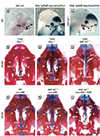Retinoic acid drives aryl hydrocarbon receptor expression and is instrumental to dioxin-induced toxicity during palate development
- PMID: 21807577
- PMCID: PMC3226489
- DOI: 10.1289/ehp.1003075
Retinoic acid drives aryl hydrocarbon receptor expression and is instrumental to dioxin-induced toxicity during palate development
Abstract
Background: Palate development depends on complex events and is very sensitive to disruption. Accordingly, clefts are the most common congenital malformations worldwide, and a connection is proposed with fetal exposure to toxic factors or environmental contaminants, such as dioxins. There is increasing evidence that dioxin interferes with all-trans-retinoic acid (atRA), a hormone-like signal derived from vitamin A, which plays an essential role during embryonic development. Although similarities have been described between dioxin-induced toxicity and the outcome of altered atRA signaling during palate development, their relationship needs to be clarified.
Objectives: We used a genetic approach to understand the interaction between atRA and dioxin and to identify the cell type targeted by dioxin toxicity during secondary palate formation in mice.
Methods: We analyzed the phenotype of mouse embryos harboring an atRA-sensitive reporter transgene or bearing null mutations for atRA-synthesizing enzymes (RALDH) or atRA receptors (RAR) and maternally exposed to 2,3,7,8-tetrachlorodibenzo-p-dioxin (TCDD) at gestation day 10.5.
Results: We found that an intact atRA signal was required to enable TCDD to induce cleft palate. This mandatory atRA signal was generated through the activity of RALDH3 in the nasal epithelium and was transduced by RARγ (RARG) in the nasal mesenchyme, where it notably controlled aryl hydrocarbon receptor (Ahr) transcript levels. TCDD also did not alter the developmental pattern of atRA signaling during palate formation.
Conclusions: TCDD-induced alteration of secondary palate development in the mouse appears to depend on atRA signaling, which controls AHR expression. This mechanism is likely conserved throughout vertebrate evolution and may therefore be relevant in humans.
Conflict of interest statement
The authors declare they have no actual or potential competing financial interests.
Figures





Similar articles
-
The mediating mechanism of Oct4 in the process of cleft palate induced by 2, 3, 7, 8-tetrachlorodibenz-p-dioxin (TCDD) and all-trans retinoic acid.Ecotoxicol Environ Saf. 2025 Apr 15;295:118102. doi: 10.1016/j.ecoenv.2025.118102. Epub 2025 Apr 7. Ecotoxicol Environ Saf. 2025. PMID: 40194363
-
Meg3-NONO-RAR axis mediates RA pathway activation in TCDD-induced cleft palate.Toxicology. 2025 Jun;514:154099. doi: 10.1016/j.tox.2025.154099. Epub 2025 Feb 28. Toxicology. 2025. PMID: 40024514
-
Aryl hydrocarbon receptor activation in genital tubercle, palate, and other embryonic tissues in 2,3,7, 8-tetrachlorodibenzo-p-dioxin-responsive lacZ mice.Toxicol Appl Pharmacol. 1998 Jul;151(1):33-44. doi: 10.1006/taap.1998.8444. Toxicol Appl Pharmacol. 1998. PMID: 9705885
-
Review of the interaction between TCDD and glucocorticoids in embryonic palate.Toxicology. 1995 Dec 28;105(2-3):365-73. doi: 10.1016/0300-483x(95)03234-7. Toxicology. 1995. PMID: 8571373 Review.
-
Mechanisms of Developmental Toxicity of Dioxins and Related Compounds.Int J Mol Sci. 2019 Jan 31;20(3):617. doi: 10.3390/ijms20030617. Int J Mol Sci. 2019. PMID: 30708991 Free PMC article. Review.
Cited by
-
Environmental mechanisms of orofacial clefts.Birth Defects Res. 2020 Nov;112(19):1660-1698. doi: 10.1002/bdr2.1830. Epub 2020 Oct 30. Birth Defects Res. 2020. PMID: 33125192 Free PMC article. Review.
-
Exposure to the persistent organic pollutant 2,3,7,8-tetrachlorodibenzo-p-dioxin (TCDD, dioxin) disrupts development of the zebrafish inner ear.Aquat Toxicol. 2023 Jun;259:106539. doi: 10.1016/j.aquatox.2023.106539. Epub 2023 Apr 12. Aquat Toxicol. 2023. PMID: 37086653 Free PMC article.
-
Long non-coding RNA H19-mediated mouse cleft palate induced by 2,3,7,8-tetrachlorodibenzo-p-dioxin.Exp Ther Med. 2016 Jun;11(6):2355-2360. doi: 10.3892/etm.2016.3195. Epub 2016 Mar 24. Exp Ther Med. 2016. PMID: 27284320 Free PMC article.
-
TCF21 and the environmental sensor aryl-hydrocarbon receptor cooperate to activate a pro-inflammatory gene expression program in coronary artery smooth muscle cells.PLoS Genet. 2017 May 8;13(5):e1006750. doi: 10.1371/journal.pgen.1006750. eCollection 2017 May. PLoS Genet. 2017. PMID: 28481916 Free PMC article.
-
Triphenyl phosphate-induced developmental toxicity in zebrafish: potential role of the retinoic acid receptor.Aquat Toxicol. 2015 Apr;161:221-30. doi: 10.1016/j.aquatox.2015.02.009. Epub 2015 Feb 19. Aquat Toxicol. 2015. PMID: 25725299 Free PMC article.
References
-
- Abbott BD, Birnbaum LS. TCDD-induced altered expression of growth factors may have a role in producing cleft palate and enhancing the incidence of clefts after coadministration of retinoic acid and TCDD. Toxicol Appl Pharmacol. 1990;106:418–432. - PubMed
-
- Abbott BD, Birnbaum LS, Perdew GH. Developmental expression of two members of a new class of transcription factors: I. Expression of aryl hydrocarbon receptor in the C57BL/6N mouse embryo. Dev Dyn. 1995;204:133–143. - PubMed
-
- Abbott BD, Harris MW, Birnbaum LS. Etiology of retinoic acid-induced cleft palate varies with the embryonic stage. Teratology. 1989;40:533–553. - PubMed
-
- Abbott BD, Held GA, Wood CR, Buckalew AR, Brown JG, Schmid J. Ahr, Arnt, and Cyp1a1 mRNA quantitation in cultured human embryonic palates exposed to TCDD and comparison with mouse palate in vivo and in culture. Toxicol Sci. 1999;47:62–75. - PubMed
-
- Balmer JE, Blomhoff R. Gene expression regulation by retinoic acid. J Lipid Res. 2002;43:1773–1808. - PubMed
Publication types
MeSH terms
Substances
LinkOut - more resources
Full Text Sources
Medical

